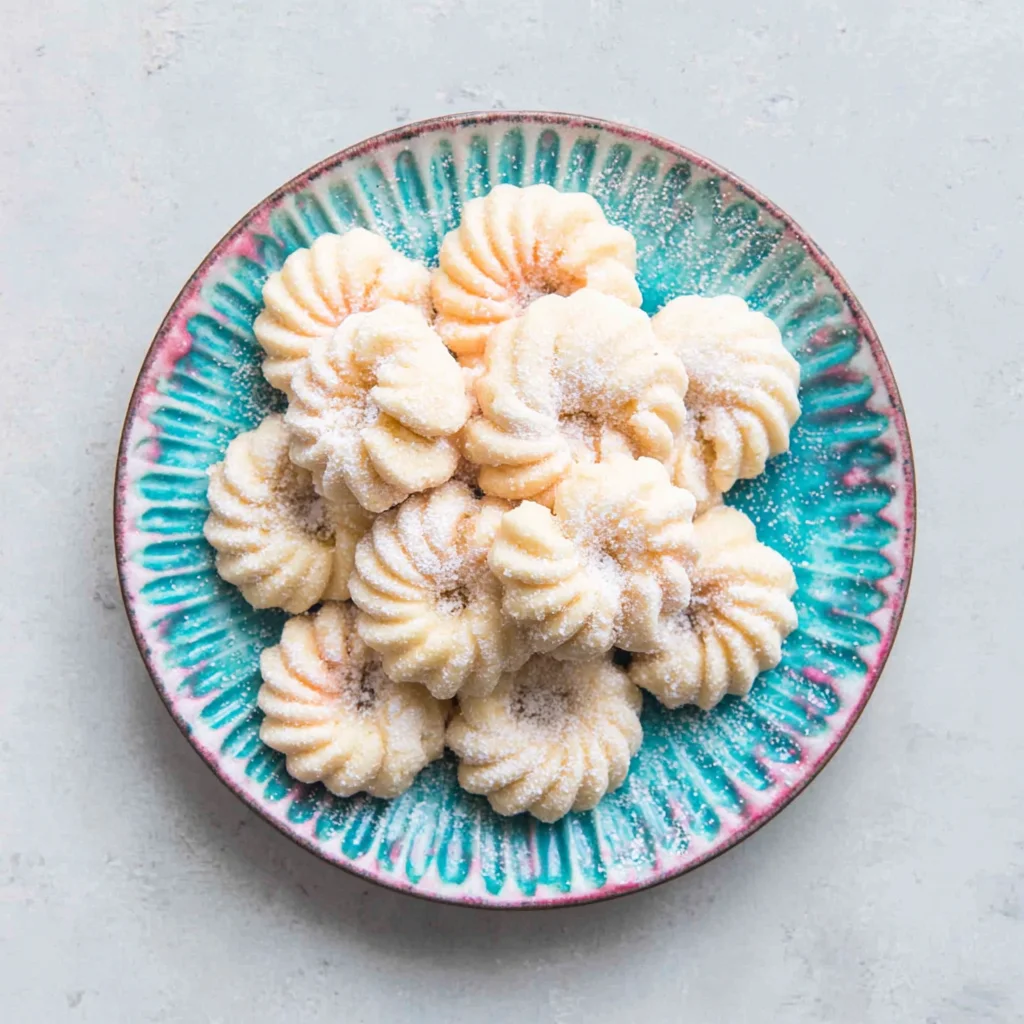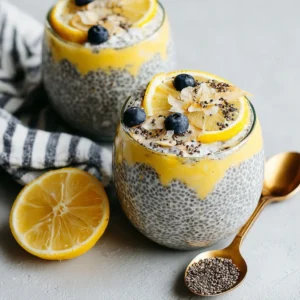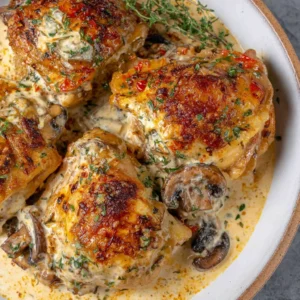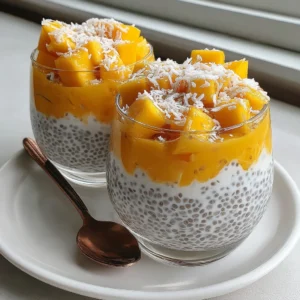There is perhaps no more iconic or beloved Christmas cookie than the humble, yet exquisite, Spritz Cookie. Originating from Scandinavia and Germany (where they are often called Spritzergebäck, meaning “squirted biscuits”), these delicate, tender treats are the quintessential holiday tradition. Their name comes from the act of pressing the dough through a specific tool the cookie press which creates beautifully intricate, uniform shapes.
Unlike roll-out sugar cookies, which require chilling and physical effort, the beauty of the Spritz Cookie lies in its ease of preparation and rich, buttery flavor profile. This recipe yields cookies that are perfectly crisp on the edges, tender in the center, and boast that unmistakable pure butter flavor that defines the best Christmas baking. If you are looking to create a stunning platter of intricate cookies with minimal fuss, you have found your new go-to recipe. We will guide you through mastering the essential technique of the cookie press, ensuring your Spritz Cookies adhere perfectly and bake up golden, light, and delicious.
We understand that baking pressed cookies can sometimes be tricky the dough must be just right, and the baking sheet preparation is non-negotiable. We have broken down every single step, from achieving that ideal soft butter texture to troubleshooting the most common pressing issues, guaranteeing your success. Prepare your kitchen for the aroma of vanilla and butter; it’s time to create some festive magic with the best classic Spritz Cookie recipe!
Why This Spritz Cookie Recipe is the Only One You Need
In a world saturated with cookie recipes, why should this classic butter Spritz Cookie version earn a permanent spot in your baking repertoire? The answer lies in the flawless balance of flavor, texture, and the unique, unmatched functionality of the dough. This recipe is specifically designed to work seamlessly with a cookie press, a tool that can be notoriously fickle with the wrong dough consistency. Many recipes are too dry, causing the dough to tear when pressed, or too wet, causing the shapes to melt immediately in the oven.
This formulation strikes the perfect balance. It is a high-fat dough, relying heavily on softened butter, which provides a tender crumb without requiring any chemical leavening agents like baking powder or soda (which can often distort the delicate shapes). The ratio of flour to fat ensures the shapes hold beautifully, resulting in cookies that look exactly like the intricate designs you choose. Furthermore, this is a truly traditional European-style shortbread cookie, meaning it focuses on the quality of its core ingredients rather than overwhelming sweetness. The flavor profile is simple, elegant, and intensely buttery the hallmark of a genuinely great Spritz Cookie.
Beyond the flawless functionality, the sensory experience of making and eating these cookies is unparalleled. Think about the joy of creating dozens of identical, delicate shapes rosettes, wreaths, trees, or stars with a simple press of a lever. These are the cookies that bring families together during the holiday season, gathering around the counter to add sparkling colored sugar or simple nonpareils before they head into the oven. If you enjoy other light, buttery holiday treats, such as these Christmas Thumbprint Cookies, you will appreciate the pure, unadulterated flavor of this Spritz Cookie base.
This recipe provides a blank canvas for decoration and flavor modifications. Whether you opt for the classic pure vanilla flavor, or introduce a hint of almond or lemon, the buttery foundation shines through. They keep exceptionally well, making them ideal for shipping, gift-giving, and long-term storage throughout the festive season. When simplicity, flavor, tradition, and reliable results are your goal, this recipe delivers on all fronts, securing its status as the ultimate butter Spritz Cookie recipe.
The Timeless Tradition: Why You Should Try Making Authentic Spritz Cookies Today
Baking homemade cookies is about more than just a sweet treat; it’s about heritage, connection, and creating memories. The process of making Spritz Cookies is inherently festive, often marking the official start of holiday baking season. This particular style of cookie has deep roots in European baking traditions, often associated with Christmas celebrations where elaborate, beautiful cookies were expected.
The visual appeal of the Spritz Cookie cannot be overstated. Unlike drop cookies, which spread and become irregular, pressed cookies offer geometric perfection. The uniform sizes bake evenly, providing consistent texture and color. Using a cookie press allows even novice bakers to produce cookies that look professionally crafted, making them perfect for cookie exchanges, gifting neighbors, or creating an impressive centerpiece for a holiday party dessert table. They truly embody the artistry of European baking.
Furthermore, mastering the cookie press is a rewarding skill. While intimidating to some, the press is designed for speed and repetition. Once you understand the fundamentals of working with dough consistency a skill this recipe emphasizes you can churn out dozens of cookies in minutes. This efficiency is critical during busy times like December. Imagine producing 6 to 8 dozen cookies in a single afternoon! This efficiency frees up time to focus on other labor-intensive projects, or perhaps to simply relax and enjoy a slice of Sugar Cookie Cheesecake while your freshly pressed batches cool.
If you are looking to introduce a new, yet classic, tradition into your home, the Spritz Cookie is the ideal candidate. The simple act of pressing the dough, watching the shapes appear, and decorating them with simple sprinkles or sanding sugar creates engaging activity for all ages. They are less messy than icing sugar cookies, and the results are almost instantaneous. Embrace the tradition; these cookies are not just a snack, they are a piece of edible history, delivering simple, unpretentious, melt-in-your-mouth joy. Trying this recipe will connect you to generations of bakers who have celebrated holidays with the pure, buttery goodness of the classic Spritz Cookie.
Essential Ingredients and Tools for the Perfect Spritz Cookie
Success with any baked good hinges on the quality and precise handling of ingredients. This is especially true for Spritz Cookies, where the dough consistency dictates whether the shapes hold or collapse. We will break down each component and the specific tools needed to ensure a flawless execution of this tender butter cookie.
Precise Ingredients for Texture and Flavor
The simplicity of the ingredients list means that each item plays a crucial, oversized role in the final texture and taste. Using the exact quantities and states listed below is non-negotiable for success with the cookie press.
Classic Butter Spritz Cookie Ingredients
- Unsalted Butter, softened: 1 cup (2 sticks). This must be truly soft, but not melted. The ideal temperature is around 68°F (20°C). If the butter is too cold, it won’t cream properly with the sugar, resulting in a dense dough that is impossible to press. If it is too warm/oily, the dough will be too loose and will not hold its pressed shape.
- Granulated Sugar: 2/3 cup. White, standard sugar. Sugar not only provides sweetness but also helps tenderize the dough and creates air pockets during the creaming process, leading to a lighter cookie.
- Large Egg: 1. Room temperature is ideal. A room-temperature egg incorporates far more smoothly into the creamed butter and sugar, creating a stable emulsion. Cold eggs can cause the mixture to curdle or separate.
- Vanilla Extract: 1 teaspoon. High-quality vanilla is recommended, as its flavor will be prominent. Alternatively, many traditional recipes use almond extract for a classic twist, which provides a distinctive marzipan-like aroma often associated with Christmas Spritz Cookies.
- Salt: 1/4 teaspoon. This is essential, as it cuts through the richness of the butter and balances the sweetness of the sugar, enhancing the overall butter flavor.
- All-Purpose Flour: 2 1/4 cups. Accuracy here is critical. Flour must be measured using the spoon-and-level method gently spoon flour into the measuring cup until overflowing, then sweep the excess off with a straight edge. Never scoop directly from the bag, as this compacts the flour, resulting in a dough that is too stiff for the cookie press.
Essential Kitchen Utensils and the Magic of the Cookie Press
While the ingredients are few, the equipment requirements are specific, particularly the namesake tool.
Required Tools for Perfect Spritz Cookies:
- Stand Mixer or Handheld Electric Mixer: Required for the creaming process (Step 2). A stand mixer with a paddle attachment offers the most consistent results, providing necessary aeration.
- Rubber Spatula: Necessary for scraping down the bowl during mixing and for loading the dough tightly into the press.
- Dry Measuring Cups and Spoons: Essential for accurate ingredient measurement, particularly for the flour and sugar.
- Wire Whisk: Used to combine the flour and salt thoroughly before adding them to the wet ingredients.
- Wire Cooling Rack: For transferring the baked cookies and allowing them to cool completely, preventing condensation and preserving crispness.
- Crucial Tool: The Cookie Press: This is non-negotiable for true Spritz Cookies. Whether you use a vintage manual screw-style press or a modern electric model, ensure it is clean and functioning correctly. Having a variety of decorative discs is part of the fun! (For inspiration on beautifully arranged cookie platters, check out our seasonal ideas on Pinterest).
- The Secret Weapon: Ungreased Metal Baking Sheets: This is perhaps the most crucial “tool.” Spritz cookies rely entirely on the cold, plain metal surface to adhere when pressed. They cannot stick to parchment paper, silicone mats, or greased surfaces. Use heavy-gauge aluminum sheets if possible.
Understanding the interplay between these elements is the key to success. The high proportion of butter creates flavor, the gentle mixing ensures tenderness, and the cookie press translates the pliable dough into intricate festive shapes that define the classic Spritz Cookie.
Step-by-Step Guide to Mastering the Cookie Press and Baking Your Spritz Cookies
The journey to perfect Spritz Cookies is straightforward but demands attention to temperature and mixing technique. Follow these steps meticulously, focusing especially on dough consistency and baking sheet preparation.
Step 1: Preparation and Gathering
- Preheat the Oven: Adjust your oven rack to the middle position and preheat your oven to 375°F (190°C). Precise temperature control is vital for achieving that light golden edge without browning the center too much.
- Prepare Baking Sheets: This step is critical. DO NOT grease the baking sheets, line them with parchment paper, or use silicone mats. Spritz Cookies must be pressed onto a plain, ungreased metal surface to properly adhere and release from the press mechanism. If the surface is slick, the dough will simply pull back up with the press.
Step 2: Creaming the Butter and Sugar (Aeration is Key)
- In the bowl of a stand mixer fitted with the paddle attachment, or using a large bowl and a handheld electric mixer, place the softened butter and the granulated sugar.
- Beat these two ingredients together on medium speed for approximately 2 to 3 minutes, or until the mixture is light in color and fluffy in texture. This process, known as creaming, incorporates air into the fat, which gives the final Spritz Cookie its characteristic light texture.
- Make sure to occasionally scrape down the sides of the bowl to ensure even mixing and that no pockets of uncreamed butter remain at the bottom.
Step 3: Incorporate Wet Ingredients (Building the Emulsion)
- Stop the mixer and add the room temperature large egg and the vanilla extract (or almond extract). Using a room-temperature egg is crucial here; it prevents the butter from solidifying and becoming grainy.
- Mix again on medium speed until the egg is fully incorporated into the creamed butter mixture, about 1 minute. The mixture may look slightly separated at first, but should come together smoothly into a uniform, pale yellow batter.
Step 4: Add Dry Ingredients and Avoid Overmixing (Developing the Dough)
- In a separate bowl, whisk together the measured all-purpose flour and the salt. This ensures the salt is evenly distributed throughout the dry ingredients, preventing pockets of flavor imbalance.
- Reduce the mixer speed to low. Gradually add the flour mixture to the wet ingredients, adding about one third of the flour at a time.
- Mix only until the flour is just combined and no streaks of dry flour remain. The dough should be soft, pliable, and hold its shape. Be very careful not to overmix, as this develops gluten, which will result in tough, dense cookies that are difficult to press and lack the signature melt-in-your-mouth texture. The dough should look and feel like a thick, moldable paste.
Step 5: Loading the Cookie Press (Critical for Spritz Cookie Success)
- Temperature Check: If your kitchen is warm or if you handled the dough excessively, the dough might be too soft or warm. If necessary, chill it in the refrigerator for about 10 to 15 minutes. Dough that is too warm will smear rather than press cleanly.
- Select your desired cookie disc shape and lock it into the cookie press barrel according to your press manufacturer’s instructions.
- Using a rubber spatula or a small spoon, carefully fill the cookie press barrel with the dough. Pack the dough in tightly to remove any air pockets. Air pockets are the number one reason a cookie press fails to function smoothly and consistently.
Step 6: Pressing the Cookies (The Spritz Technique)
- Place the base of the cookie press firmly and flatly against the ungreased baking sheet.
- Press the lever or turn the crank once, depending on your model. You must feel the dough adhere to the cool metal sheet and see the cookie shape cleanly release.
- Lift the cookie press straight up. Troubleshooting Adhesion: If the cookie does not stick to the sheet, the dough is likely too warm, or the sheet is subtly greasy (even from a previous batch of cookies). Wipe the sheet clean with a dry paper towel and/or chill the dough for 5 minutes and try again. The first few presses sometimes need adjustment.
- Space the cookies approximately 1 to 2 inches apart on the baking sheets.
- If desired, immediately decorate the cookies before baking with colored sprinkles or colored sugar crystals. Sprinkles adhere best before the dough starts to warm up in the oven.
Step 7: Baking and Cooling
- Bake the cookies in the preheated 375°F (190°C) oven for 8 to 12 minutes. Baking time will vary based on the size and thickness of your pressed shapes. Small, delicate shapes require less time.
- The cookies are finished baking when the edges are lightly set and the very bottom rim just begins to turn a faint golden brown color. They should remain very pale in the center. Over-baking results in a dry, less tender cookie.
- Remove the baking sheets from the oven and allow the cookies to cool on the sheets for 2 to 3 minutes. This short cooling period helps them firm up and prevents breakage.
- Carefully transfer the slightly cooled Spritz Cookies to a wire cooling rack using a thin spatula.
- Allow the cookies to cool completely before serving or storing. Store cooled cookies in an airtight container at room temperature for up to one week.
Tips, Flavor Variations, and Troubleshooting Your Spritz Cookie Dough
While the basic recipe is flawless, there are several ways to customize the flavor, adjust the texture, and prevent the common pitfalls associated with using a cookie press. Achieving the perfect pressed cookie is highly dependent on dough condition.
Essential Troubleshooting for the Cookie Press
The biggest challenge with Spritz Cookies is ensuring they press cleanly and stick to the sheet. If you encounter issues, here are the likely culprits and solutions:
- Problem: The dough pulls back up with the press.
- Solution: Your baking sheet is likely too warm or too greasy. Ensure you use completely ungreased, cool metal sheets. If the sheets were used for a previous batch, wipe them down thoroughly with a dry towel and let them cool completely before pressing more dough.
- Solution: The dough is too warm. Pop the filled press (or just the dough) into the refrigerator for 5-10 minutes.
- Problem: The shapes are misshapen or ragged (tearing).
- Solution: The dough is too cold or dry. If the dough was chilled, let it sit on the counter for a few minutes to soften slightly. If it feels too stiff, mix in 1/2 teaspoon of milk or cream to slightly increase the moisture level.
- Solution: Air pockets in the press. Remove the dough, repack it tightly, and ensure the press is fully primed.
- Avoiding Overmixing: Remember the core rule: stop mixing immediately when the last streaks of flour disappear (Step 4). Overmixing develops gluten, turning your buttery shortbread into a chewy, tough cookie that won’t press easily or melt delightfully in your mouth. This rule is consistent across delicate butter cookies, like our Whipped Shortbread Cookies.
Flavor and Color Variations
The classic butter base is infinitely adaptable:
- Almond Spritz: Substitute the vanilla extract entirely with 1 teaspoon of pure almond extract for a traditional European flavor.
- Lemon Zest: Add 1 tablespoon of finely grated lemon zest to the wet ingredients (Step 3). This provides a bright, refreshing flavor, perfect for non-holiday batches.
- Chocolate Spritz Cookie: Sift 1/4 cup of unsweetened cocoa powder along with the flour and salt. You may need to reduce the flour slightly (by 1-2 tablespoons) to maintain the correct pressing consistency.
- Coloring the Dough: For festive batches, divide the dough before adding the flour (Step 4). Add gel food coloring (avoid liquid food coloring, as it adds too much moisture) to the wet ingredients and mix until uniform. Then, slowly incorporate the flour into each colored section.
- Dipping Variation: Once completely cool, dip the Spritz Cookie in melted tempered white or dark chocolate and immediately cover with crushed peppermint candies or chopped nuts.
Ingredient Alternatives (Vegan and Gluten-Free)
Adapting this classic recipe requires careful substitution, as the original relies heavily on specific dairy and gluten structures:
- Gluten-Free Spritz: Substitute the all-purpose flour with a high-quality 1:1 gluten-free baking blend that contains xanthan gum. You may find the dough is slightly more crumbly, so be prepared to add 1/2 to 1 teaspoon of cold water if the dough won’t come together smoothly after mixing.
- Vegan Spritz: Substitute the butter with high-quality, plant-based stick butter (do not use tub margarine). Ensure it is softened to the correct temperature. Substitute the egg with 1/4 cup of thick, unsweetened applesauce, or a commercial egg replacer that is suitable for baking. Note that vegan butter often has a higher moisture content, so you may need to chill the dough longer before pressing.
By controlling the temperature and avoiding overmixing, you ensure that your classic butter Spritz Cookies press flawlessly, maintaining their delicate shape and delicious, tender crumb.
Nutritional Overview and the Joy of Homemade Cookies
While the Spritz Cookie is certainly a delightful indulgence, understanding the nutritional content and the general benefits of choosing homemade baking is valuable. This recipe yields a high number of cookies (approximately 6 to 8 dozen, depending on the size of the pressed shape), meaning individual portion sizes are typically small.
Estimated Nutritional Values (Per 1 Small Spritz Cookie – Estimate)
These values are estimates based on a yield of 72 cookies and may vary significantly based on the size of your pressed shapes and whether you add decorations like sprinkles.
| Nutrient | Approximate Value |
|---|---|
| Calories | 55–65 kcal |
| Total Fat | 3–4 g |
| Saturated Fat | 2–2.5 g |
| Carbohydrates | 6–8 g |
| Sugars | 3–4 g |
| Protein | < 1 g |
The primary source of calories and fat comes from the high proportion of unsalted butter, which is essential for achieving the shortbread texture. Since these cookies are enjoyed seasonally and in small quantities, they are intended as a high-quality treat rather than a nutritional staple.
The Benefits of Baking at Home
Beyond the caloric count, there are significant benefits to preparing holiday treats like Spritz Cookies from scratch:
- Ingredient Control: When you bake at home, you control exactly what goes into the dough. This recipe uses basic, recognizable ingredients real butter, sugar, and flour avoiding the artificial preservatives, colors, and high-fructose corn syrup often found in commercially produced cookies.
- Mental Wellness and Stress Reduction: Baking is often cited as a therapeutic activity. The rhythmic nature of creaming the butter, the satisfying sound of the mixer, and the focus required for using the cookie press can be incredibly calming and stress-relieving during busy holiday periods.
- Creating Tradition: The sheer act of making and decorating Spritz Cookies creates powerful sensory memories. The aroma of baking butter and vanilla is indelibly linked to holiday cheer, building family traditions that last for generations.
- Flavor Superiority: Nothing compares to the fresh, pure flavor of a cookie made with high-quality butter, eaten just hours after it has cooled. The flavor of a classic butter Spritz Cookie is rich, clean, and unmistakably superior to anything store-bought.
By preparing these traditional cookies, you are investing not only in a delicious dessert but also in the emotional and traditional richness of your home environment.
Frequently Asked Questions About Spritz Cookies
The cookie press can be daunting, but these answers to common questions will ensure your baking experience is smooth and successful.
Can I chill Spritz Cookie dough ahead of time?
Generally, no. Unlike slice-and-bake cookies, Spritz Cookie dough must be pliable and warm enough to easily flow through the press discs. If you must prepare the dough ahead, wrap it tightly and refrigerate it. Before using, allow it to warm up on the counter for 30–60 minutes until it is soft enough to press without tearing.
What is the secret to getting Spritz Cookies to stick to the baking sheet?
The absolute secret is using cool, completely bare, ungreased metal baking sheets. The dough relies on the clean metal surface to provide enough friction to adhere when the press lifts. Parchment paper, silicone mats, or even lingering grease will cause the dough to pull back up.
How do I store baked Spritz Cookies?
Allow the cookies to cool completely before storing them. Place them in an airtight container at room temperature. They maintain their freshness and crisp texture for up to one week. They also freeze very well; layer them with wax paper in a freezer-safe container for up to three months.
Why are my Spritz Cookies losing their shape when baking?
If your cookies spread and lose their intricate shape, the dough was likely too warm or the butter was too soft/oily when the flour was incorporated. Ensure your butter is just soft, not shiny or melted. Also, verify your flour measurement was accurate, using the spoon-and-level method, as too little flour causes spreading.
Can I use flavored extracts other than vanilla or almond in this Spritz Cookie recipe?
Absolutely! The base dough is versatile. Try peppermint extract (use only 1/2 teaspoon, as it is very strong), lemon extract, or coconut extract. Just maintain the total liquid quantity (1 teaspoon) to preserve the perfect dough consistency required for the cookie press.
My dough won’t come out of the cookie press evenly. What am I doing wrong?
This usually indicates air pockets in the press barrel. You must pack the dough down very tightly, especially if you are refilling the barrel. Consistent pressure is necessary to force the dough smoothly through the disc. If the press still struggles, the dough may be too stiff (too cold or too much flour), requiring slight warming or the addition of a few drops of milk.
Conclusion: The Joy of a Perfectly Pressed Spritz Cookie
The classic butter Spritz Cookie remains a beloved staple of holiday baking for excellent reasons. Its rich, tender texture, derived from the high butter content, melts in your mouth, providing a simple yet sophisticated flavor that complements any festive spread. By following the precise measurements and techniques outlined in this guide especially the non-negotiable step of using softened but not melted butter, carefully measuring flour, and utilizing ungreased baking sheets you can overcome the common hurdles associated with the cookie press and achieve flawlessly formed, bakery-quality results.
We’ve armed you with the essential knowledge, from the importance of creaming the butter for aeration to crucial troubleshooting tips if your cookies refuse to adhere to the sheet. Whether you choose the purity of vanilla or the classic twist of almond, this recipe guarantees a cookie that is structurally perfect and delightfully delicious. The act of creating these delicate rosettes and stars is a beautiful way to engage with the timeless tradition of European holiday baking.
Gather your ingredients, dust off your cookie press, and start a delicious new holiday tradition today. We encourage you to try the classic Spritz Cookie and share the joy of these beautiful, buttery bites with your friends and family. Let us know in the comments below which disc shape was your favorite! Happy baking!
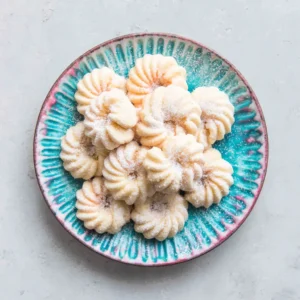
#Classic Butter Spritz Cookie Recipe
Equipment
- Stand Mixer (or Handheld Mixer)
- Cookie Press
- Baking Sheets (ungreased)
- Wire Cooling Rack
Ingredients
Classic Spritz Cookie Dough
- 1 cup Unsalted Butter, softened Must be truly soft, but not melted (2 sticks).
- 2/3 cup Granulated Sugar White, standard sugar.
- 1 Large Egg Room temperature is ideal.
- 1 teaspoon Vanilla Extract Or use almond extract for a classic twist.
- 1/4 teaspoon Salt Balances the sweetness.
- 2 1/4 cups All-Purpose Flour Use the spoon-and-level method for accuracy.
Optional Decoration
- Colored Sprinkles or Sugar Crystals For decorating immediately before baking.
Instructions
Step 1: Preparation and Gathering
- Preheat the Oven: Adjust your oven rack to the middle position and preheat your oven to 375°F (190°C).
- Prepare Baking Sheets: Crucially, DO NOT grease the baking sheets, line them with parchment paper, or use silicone mats. Spritz cookies require a plain, ungreased metal surface to properly adhere when pressed.
Step 2: Creaming and Wet Ingredients
- In the bowl of a stand mixer fitted with the paddle attachment, or using a large bowl and a handheld electric mixer, place the softened butter and the granulated sugar. Beat on medium speed for approximately 2 to 3 minutes, or until the mixture is light in color and fluffy in texture. Scrape down the sides of the bowl.
- Stop the mixer and add the room temperature large egg and the vanilla extract. Mix again on medium speed until the egg is fully incorporated, about 1 minute. The mixture should come together smoothly.
Step 3: Incorporate Dry Ingredients
- In a separate bowl, whisk together the measured all-purpose flour and the salt.
- Reduce the mixer speed to low. Gradually add the flour mixture to the wet ingredients, adding about one third of the flour at a time. Mix only until the flour is just combined and no streaks of dry flour remain. The dough should be soft and pliable. Do not overmix.
Step 4: Pressing the Cookies
- Prepare the Press: If the dough is too soft or warm, chill it for 10 to 15 minutes. Select your desired cookie disc shape and lock it into the cookie press barrel. Carefully fill the cookie press barrel with the dough, packing it in tightly to remove any air pockets.
- Pressing: Place the base of the cookie press firmly against the ungreased baking sheet. Press the lever or turn the crank once until the cookie shape adheres to the sheet and releases. Lift the press straight up. If the cookie does not stick, ensure your sheets are completely clean and the dough is cool enough.
- Space the cookies approximately 1 to 2 inches apart. Immediately decorate the cookies before baking with colored sprinkles or colored sugar crystals, if desired.
Step 5: Baking and Cooling
- Bake the cookies in the preheated 375°F (190°C) oven for 8 to 12 minutes, depending on size. The cookies are finished when the edges are lightly set and the very bottom rim just begins to turn a faint golden brown color. They should remain pale in the center.
- Remove the baking sheets from the oven and allow the cookies to cool on the sheets for 2 to 3 minutes. Carefully transfer the slightly cooled spritz cookies to a wire cooling rack using a thin spatula. Allow them to cool completely before serving or storing.
